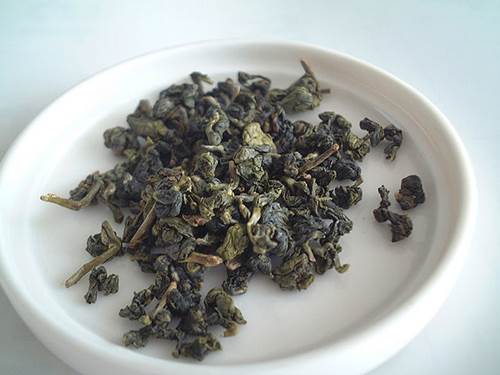 Oolong Tea Leaves – Image Courtesy: Shizhao
Oolong Tea Leaves – Image Courtesy: Shizhao
The breadth and depth of oolong teas often leads to confusion over what exactly an oolong tea is. Last week we talked about Yellow Teas and how they are allowed to oxidize or “stew” for a while, which gives them a darker color and a more complex collection of flavors and aromas than that of whites or greens. Yellows oxidize perhaps as much as 15% of the leaf, but not much more.
Oolongs on the other hand, are allowed to stew for much longer, oxidizing or “cooking” as much as 70% of the leaf. The bare minimum for an oolong is generally agreed to be 30%, which translates into 4-5 days of stewing, depending on conditions. Given such a wide range, the key to an oolong is when to stop.
Oolong Tea is a ‘Work of Art’
As with all good teas, oolongs are a work of art and truly good varieties require a master craftsman at every stage: cultivation, picking, fermenting/oxidizing, and the final stage, which is roasting.
Each stage has its own special secrets and techniques, thus we have oolongs as diverse as Tie Guanyin, which is often light green with hints of reddish orange and brews yellow to gold and Da Hong Pao, which is a dark black leaf, slightly rolled and brews caramel to reddish brown.
Fujian Province – The ‘Mother’ of Oolong Cultivation
Fujian is the undisputed master of oolong teas. Taiwan, Guangdong and Zhejiang also grow oolongs (as well as Vietnam, Thailand and other places) but all bow down before the mother of oolong cultivation, Fujian Province. In Fujian, there are two areas that have been growing the tea for centuries: Wuyi and Anxi. Wuyi lays claim to the Four Great Oolongs, which are the Da Hong Pao, Shui Jin Gui, Tie Luo Han and Bai Ji Guan varieties. Anxi is renowned for Tie Gunayin, which is actually much more well known than Wuyi teas.
Tie Guanyin – The “People’s Oolong”
Some people say that Tie Guanyin is the “people’s oolong,” because it is lighter, more floral and easier to handle than the complex and refined Wuyi varieties. I have found this to be true in most cases. But Tie Guanyin (as with ALL other varieties of tea) is not a static standard that is followed dogmatically by tea slaves. It is a certain type of bush that grows in a certain type of climate and has been processed in a certain way as to create an identifiable taste. What one does within those parameters is a whole other thing.
I have an aged Tie Guanyin right now (1991) that is one of the most complex and beautifully crafted teas I have seen. It has been roasted repeatedly over the past 25 years according to a method and principle that only the master who roasted it can truly know. The result is a tea with many layers and many personalities.
Just as well, I love to drink a standard spring Tie Guanyin that has been fermented a bit and then sent off to the market. Sure, the quality and staying power of the tea (staying power meaning number of steeps possible) might not be the best, but it is a light and refreshing tea with a fine floral aroma and perfect for an afternoon with a couple of buddies. This is really what makes oolong teas so nice: you can easily find some tasty oolongs that are not a problem to brew and still take you away to a special place OR you can go all out and find a tea that has been crafted by a master who has a firm grasp of the possibilities inherent in a tea that can be oxidized anywhere from 30 – 70 percent and then roasted as often as one feels necessary.
Oolongs for Losing Weight
Oolongs are also believed to help one lose weight. Like the same process I described in my first post about white tea, oolong works specifically by impeding fat molecules from hanging around your belly. Oolongs do not “destroy” fat or remove existing fat from your body, instead they help the body process fats and oils, thereby preventing them from collecting.
This is just one benefit among many; personally, I have experienced some pretty transcendent afternoons drinking oolong tea. It helps me relax, dream, think clearly, it alters my mood (usually for the better) and it cleans my mouth, throat and presumably belly of bacteria and oils.
Brewing Oolongs
Oolongs are diverse and therefore the brewing methods are also diverse. The one constant is the use of a clay pot. Glass is fine and won’t do any damage, but a fine clay pot really does make a difference in the flavor and aroma. The best way to decide if glass or clay (or even iron!) is best for you is to try it all out.
Oolongs can handle long steeps and hot water. Try starting with 80 degrees water and one minute steeps, then play around with maybe 90 degree water and 3 minute steeps; see what happens to the color, the aroma and the taste. I have found that within one session, different times with constant temperature is the best way. Oolongs do not work well in glasses or cups; they require a steep to get all of the roasting and oxidizing out of the leaf and into the brew. A Gaiwan is great, but has to be used as a pot — that is, brew it in a Gaiwan, but pour it into a another cup.
A Favorite With Tea Aficionados
Basically, the more in-depth the process to create a tea, the more possibilities there are for different flavors and ways one can tease those flavors out. Oolongs are a favorite with tea aficionados because of the wide range (30 – 70 percent oxidation/multiple roastings possible) and the fun one can have brewing such a tea (do I let it sit for one, two or five minutes?). And most importantly, enjoy!
 Sascha Matuszak is a German-born American writer and is currently based out of Chengdu, Sichuan Province, China.
Sascha Matuszak is a German-born American writer and is currently based out of Chengdu, Sichuan Province, China.
David Askaripour says
So I’m assuming that Oolongs have a lot less antioxidant power than Greens due to the increased oxidation? How would you compare the health benefits between the two? Thanks for the amazing information on tea.
David Askaripour says
Thanks for sharing, much appreciated! I once read a book on tea called , I think, “The book of green tea.” And it went into the depth of health benefits of green tea. Speaking about: cancer, AIDS, bad breath, circulatory system, memory, etc… In that, green tea helps to combat these things. Additionally, the book started of by declaring green tea as an ancient medicine that the Chinese have been using to cure ailments for thousands of years. For me, tea is, more than anything, a spiritual drink / experience… but I’m also VERY intrigued on the health benefits as well….
Emi says
I worked in a biochem lab in Japan for a while where they worked out the mechanism whereby oolong tea helps weight loss. I don’t know if they published though because I was only there when they made preliminary findings.
In essence oolong tea contains something which interferes with an enzyme pathway in metabolism (if I remember rightly the electron transport chain, it’s a long time ago though) making it less efficient. So your body needs to process more calories to get the same amount of usable energy. I In the same way that a car with low fuel efficiency burns more petrol. As I said I would post links to published evidence but I don’t know if they did publish.